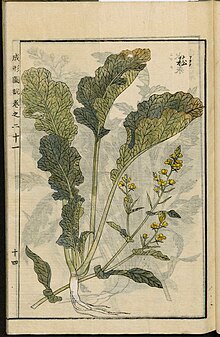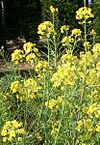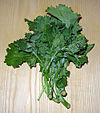Brassica rapa
| Brassica rapa | |
|---|---|

| |
| Scientific classification | |
| Kingdom: | Plantae |
| Clade: | Tracheophytes |
| Clade: | Angiosperms |
| Clade: | Eudicots |
| Clade: | Rosids |
| Order: | Brassicales |
| Family: | Brassicaceae |
| Genus: | Brassica |
| Species: | B. rapa
|
| Binomial name | |
| Brassica rapa | |

Brassica rapa is a plant species that has been widely cultivated into many forms, including the turnip (a root vegetable), komatsuna, napa cabbage, bomdong, bok choy, and rapini.
Brassica rapa subsp. oleifera is an oilseed commonly known as rape, field mustard, bird's rape, and keblock.[2][3][4][5][6][7] Rapeseed oil is a general term for oil from some Brassica species. Food grade oil made from the seed of low-erucic acid Canadian-developed strains is also called canola oil, while non-food oil is called colza oil.[2] Canola oil can be sourced from Brassica rapa and Brassica napus, which are commonly grown in Canada, and Brassica juncea, which is less common.[8]
History
[edit]
The geographic and genetic origins of B. rapa have been difficult to identify due to its long history of human cultivation. It is found in most parts of the world, and has returned to the wild many times as a feral plant or weed.
Genetic sequencing and environmental modelling have indicated that ancestral B. rapa likely originated 4000 to 6000 years ago in the Hindu Kush area of Central Asia, and had three sets of chromosomes, providing the genetic potential for a diversity of form, flavour, and growth. Domestication has produced modern vegetables and oil-seed crops, all with two sets of chromosomes.[9][10]
Oilseed subspecies (subsp. oleifera) of Brassica rapa may have been domesticated several times from the Mediterranean to India, starting as early as 2000 BC.[11] There are descriptions of B. rapa vegetables in Indian and Chinese documents from around 1000 BC.[9]
Edible turnips were possibly first cultivated in northern Europe, and were an important food in ancient Rome.[11] The turnip then spread east to China, and reached Japan by 700 AD.[11]
In the 18th century, the turnip and the oilseed-producing variants were thought to be different species by Carl Linnaeus, who named them B. rapa and B. campestris. Twentieth-century taxonomists found that the plants were cross fertile and thus belonged to the same species. Since the turnip had been named first by Linnaeus, the name Brassica rapa was adopted.[12]
Uses
[edit]Many butterflies, including the small white, feed from and pollinate the B. rapa flowers.
The young leaves are a common leaf vegetable and can be eaten raw; older leaves are typically cooked. The taproot and seeds can also be eaten raw, although the seeds contain an oil[which?] that can cause irritation for some people.[13]
Cultivars
[edit]| Cultivar | Image | Name |
|---|---|---|
| Bok choy |  |
Brassica rapa subsp. chinensis |
| Bomdong |  |
Brassica rapa var. glabra |
| Choy sum |  |
Brassica rapa subsp. parachinensis |
| Field mustard |  |
Brassica rapa subsp. oleifera |
| Komatsuna |  |
Brassica rapa subsp. perviridis |
| Mizuna |  |
Brassica rapa var. nipposinica |
| Napa cabbage |  |
Brassica rapa subsp. pekinensis |
| Rapini |  |
Brassica rapa var. ruvo |
| Tatsoi |  |
Brassica rapa subsp. narinosa |
| Turnip |  |
Brassica rapa subsp. rapa |
| Yellow sarson |  |
Brassica rapa subsp. trilocularis |
References
[edit]- ^ "Brassica rapa L." Plants of the World Online. Royal Botanic Gardens, Kew. Retrieved 22 August 2022.
- ^ a b "Brassica rapa subsp. oleifera". Germplasm Resources Information Network. Agricultural Research Service, United States Department of Agriculture. Retrieved 13 April 2013.
- ^ "Brassica rapa subsp. oleifera". Turnip Rape. EOL. Retrieved 13 April 2013.
- ^ Clive Stace (1997). New Flora of the British Isles. Cambridge: Cambridge. ISBN 978-0-521-58935-2.
- ^ Bailey's Dictionary (5th reprint ed.). 1731.
- ^ Doreathea Hurst (1889). History and Antiquities of Horsham. Farncombe & Co.
- ^ "Brassica rapa". Bioimages. cas.vanderbilt.edu. 2011. Archived from the original on 27 June 2010. Retrieved 10 June 2010.
- ^ "History of Canola Seed Development | Canola Encyclopedia".
- ^ a b Tarlach, Gemma (11 June 2021). "The Deep Roots of the Vegetable That 'Took Over the World'". Atlas Obscura. Retrieved 30 June 2021.
- ^ McAlvay, Alex C; Ragsdale, Aaron P; Mabry, Makenzie E; Qi, Xinshuai; Bird, Kevin A; Velasco, Pablo; An, Hong; Pires, J Chris; Emshwiller, Eve (2021). "Brassica rapa Domestication: Untangling Wild and Feral Forms and Convergence of Crop Morphotypes". Molecular Biology and Evolution. 38 (8): 3358–3372. doi:10.1093/molbev/msab108. PMC 8321528. PMID 33930151.
- ^ a b c Sanderson, Helen (2005). Prance, Ghillean; Nesbitt, Mark (eds.). The Cultural History of Plants. Routledge. p. 72. ISBN 0415927463.
- ^ Phil Thomas, ed. (2003). "Canola Varieties". Canola Growers Manual. Canola Council of Canada. Archived from the original on 12 July 2009.
- ^ Benoliel, Doug (2011). Northwest Foraging: The Classic Guide to Edible Plants of the Pacific Northwest (Rev. and updated ed.). Seattle, WA: Skipstone. pp. 83–84. ISBN 978-1-59485-366-1. OCLC 668195076.
External links
[edit] Media related to Brassica rapa at Wikimedia Commons
Media related to Brassica rapa at Wikimedia Commons- " Multilingual taxonomic information". University of Melbourne.
- PROTA (Plant Resources of Tropical Africa) database record on Brassica rapa L.
